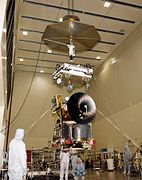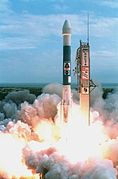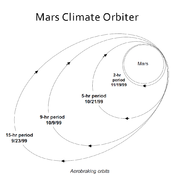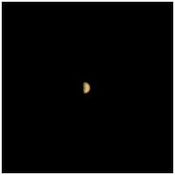- Mars Climate Orbiter
-
Mars Climate Orbiter 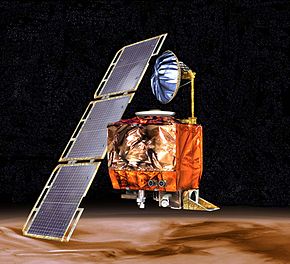
Artist's conception of the Mars Climate Orbiter.
Operator NASA / JPL Major contractors Lockheed Martin Astronautics Mission type Orbiter Satellite of Mars Launch date 1998-12-11 18:45:51 UTC
(12 years, 11 months and 10 days ago)Launch vehicle Delta II 7425 / Star 48 Launch site Space Launch Complex 17A
Cape Canaveral Air Force StationMission duration Failure in transit
(Last contact on day 286)
(1999-9-23 09:06:00 UTC)COSPAR ID 1998-073A Homepage Mars Climate Orbiter Website Mass 338 kg (750 lb) Power 500 W
(Solar array / NiH2 batteries)The Mars Climate Orbiter (formerly the Mars Surveyor '98 Orbiter) was a 338 kilogram (750 lb) robotic space probe launched by NASA on December 11, 1998 to study the Martian climate, atmosphere, surface changes and to act as the communications relay in the Mars Surveyor '98 program, for Mars Polar Lander. However, on September 23, 1999, communication with the spacecraft was lost as the spacecraft went into orbital insertion, due to a navigational error. The spacecraft encountered Mars at an improperly low altitude, causing it to incorrectly enter the upper atmosphere and disintegrate.[1][2]
Contents
Mission background
History
After the loss of Mars Observer and the onset of the rising costs associated with the future International Space Station, NASA began seeking cheaper, smaller solutions to scientific interplanetary missions. In 1994, the Panel on Small Spacecraft Technology was established to set guidelines for future miniature spacecraft. The panel determined that the new line of miniature spacecraft should be under 1000 kilograms with highly focused instrumentation.[3] In 1995, a new Mars Surveyor program began as a set of missions designed with limited objectives, low costs, and frequent launches. The first mission in the new program was Mars Global Surveyor, launched in 1996 to map Mars and provide geologic data using instruments intended for Mars Observer.[4] Following Mars Global Surveyor, Mars Climate Orbiter carried two instruments, one originally intended for Mars Observer, to study the climate and weather of Mars.
The primary science objectives of the mission included[5]:
- determine the distribution of water on Mars
- monitor the daily weather and atmospheric conditions
- record changes on the martian surface due to wind and other atmospheric effects
- determine temperature profiles of the atmosphere
- monitor the water vapor and dust content of the atmosphere
- look for evidence of past climate change.
Spacecraft design
The Mars Climate Orbiter bus measured 2.1 meters tall, 1.6 meters wide and 2 meters deep. The internal structure is largely constructed with graphite composite/aluminum honeycomb supports, a design found in many commercial airplanes. With exception to the scientific instruments, battery and main engine, the spacecraft includes dual redundancy on the most important systems.[5][6]
The spacecraft was 3-axis stabilized and included eight, hydrazine monopropellant thrusters (four 22N thrusters to perform trajectory corrections; four 0.9N thrusters to control attitude). Orientation of the spacecraft was determined with a star tracker, two Sun sensors and two inertial measurement units. Orientation was controlled by firing the thrusters or using three reaction wheels. To perform the Mars orbital insertion maneuver, the spacecraft also included a LEROS 1B main engine rocket,[7] providing 640N of thrust by burning hydrazine fuel with nitrogen tetroxide (NTO) oxidizer.[5][6]
The spacecraft included a 1.3 meter high-gain antenna to transceive data with the Deep Space Network over the x-band. The radio transponder designed for the Cassini–Huygens mission was used as a cost saving measure. The orbiter also included a two-way UHF radio frequency system to relay communications with Mars Polar Lander upon an expected landing on December 3, 1999.[5][6][8]
The space probe was powered with a 3-panel solar array, providing an average of 500 W at Mars. Deployed, the solar array measures 5.5 meters in length. Power is stored in 12-cell, 16-amp-hour Nickel hydrogen batteries. The batteries were intended to be recharged when the solar array received sunlight and power the spacecraft as it passed into the shadow of Mars. When entering into orbit around Mars, the solar array was to be utilized in the aerobraking maneuver, to slow the spacecraft until a circular orbit was achieved. The design is largely adapted from guidelines from the Small Spacecraft Technology Initiative outlined in the book, Technology for Small Spacecraft.[5][6][9]
In an effort to simplify previous implementations of computers on spacecraft, Mars Climate Orbiter featured a single computer using an IBM RAD6000 processor capable of 5MHz, 10MHz and 20MHz operations. Data storage is maintained on 128MB of random-access memory (RAM) and 18MB of flash memory. The flash memory was intended to be used for highly important data, including triplicate copies of the flight system software.[5]
The cost of the mission was $327.6 million total for both orbiter and lander, $193.1 million for spacecraft development, $91.7 million for launching it, and $42.8 million for mission operations.[10]
Scientific instruments
Pressure Modulated Infrared Radiometer (PMIRR) 
Objectives [11] - Map the three-dimensional and time-varying thermal structure of the atmosphere from the surface to 80 km altitude.
- Map the atmospheric dust loading and its global, vertical and temporal variation.
- Map the seasonal and spatial variation of the vertical distribution of atmospheric water vapor to an altitude of at least 35 km.
- Distinguish between atmospheric condensates and map their spatial and temporal variation.
- Map the seasonal and spatial variability of atmospheric pressure.
- Monitor the polar radiation balance.
Utilizes narrow-band radiometric channels and two pressure modulation cells to measure atmospheric and surface emissions in the thermal infrared and a visible channel to measure dust particles and condensates in the atmosphere and on the surface at varying longitudes and seasons.[12]
- Principal investigator: Daniel McCleese / JPL/CALTECH
- similar objectives achieved with Mars Climate Sounder on board Mars Reconnaissance Orbiter
Mars Color Imager (MARCI) 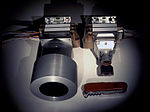
-see diagramObjectives [13] - Observe martian atmospheric processes at global scale and synoptically.
- Study details of the interaction of the atmosphere with the surface at a variety of scales in both space and time.
- Examine surface features characteristic of the evolution of the martian climate over time.
Filters [13] Medium Angle Camera Filters Filter Name Wavelength Sensitivity ''''''MA1445nm'''MA2501nmMA3562nm'''MA4639nmMA5767nmMA6829nmN/AMA7903nmN/AMA81002nmN/AWide Angle Camera Filters Filter Name Wavelength Sensitivity UV1280nmN/AUV2315nmN/A'''WA1453nm'''WA2561nmWA3614nmWA4636nmWA5765nm'''''''''The Mars Color Imager is a two-camera (medium-angle/wide-angle) imaging system designed to obtain pictures of the martian surface and atmosphere. Under proper conditions, resolutions up to 1 kilometer (0.5 miles) are possible.[13][14]
- Principal investigator: Michael Malin / Malin Space Science Systems (website)
- reincorporated on Mars Reconnaissance Orbiter
Images of the spacecraft Diagram of Mars Climate Orbiter.Mars Climate Orbiter during assembly.Mars Climate Orbiter undergoing acoustic testing.Mars Climate Orbiter awaiting a spin test in November 1998.Mission profile
Timeline of travel Date Event 1998-12-11Spacecraft launched at 18:45:51 UTC 1999-9-23Mars orbital insertion maneuver. Time Event 08:41:00 UTCOrbiter stows solar array. 08:50:00 UTCOrbiter turns to correct orientation to begin main engine burn. 08:56:00 UTCOrbiter fires pyrotechnic devices which open valves to begin pressurizing the fuel and oxidizer tanks. 09:00:46 UTCMain engine burn starts; expected to fire for 16 minutes 23 seconds. 09:06:00 UTCOrbiter expected to enter Mars occultation, out of radio contact with Earth. • 09:27:00 UTCExpected to exit Mars occultation. • • = Events that are unaccounted for but planned for the mission.
1999-09-23Communication with spacecraft lost at 09:04:52 UTC. 1999-09-25Mission declared a loss. No further attempts to contact. Launch and trajectory
The Mars Climate Orbiter probe was launched on December 11, 1998 at 18:45:51 UTC by the National Aeronautics and Space Administration from Space Launch Complex 17A at the Cape Canaveral Air Force Station in Florida, aboard a Delta II 7425 launch vehicle. The complete burn sequence lasted 42 minutes bringing the spacecraft into a Hohmann transfer orbit, with a final velocity of 5.5 km/s relative to Mars, and sending the probe into a 669 million kilometer trajectory.[5][8] At launch, Mars Climate Orbiter weighed 638 kilograms (1,418 pounds) including propellant.[15]
Exploded diagram of Delta II launch vehicle with Mars Climate OrbiterLaunch of Mars Climate Orbiter on a Delta II 7425 launch vehicle.Interplanetary trajectory of Mars Climate Orbiter.Aerobraking procedure to place Mars Climate Orbiter into orbit.Encounter with Mars
See also: Exploration of MarsMars Climate Orbiter began the planned orbital insertion maneuver on September 23, 1999 at 09:00:46 UTC. However, due to complications arisen from human error, the spacecraft encountered Mars at a lower than anticipated altitude and disintegrated due to atmospheric stresses. Mars Reconnaissance Orbiter has since completed most of the intended objectives for this mission.
Communications loss
On September 23, 1999, during the Mars orbital insertion maneuver, Mars Climate Orbiter went out of radio contact when the spacecraft passed behind Mars at 09:04:52 UTC, 49 seconds earlier than expected, and communication was never reestablished.
On November 10, 1999, the Mars Climate Orbiter Mishap Investigation Board released a Phase I report, detailing the suspected issues encountered with the loss of the spacecraft. Previously, on September 8, 1999, Trajectory Correction Maneuver-4 was computed and then executed on September 15, 1999. It was intended to place the spacecraft at an optimal position for an orbital insertion maneuver that would bring the spacecraft around Mars at an altitude of 226 kilometers on September 23, 1999. However, during the week between TCM-4 and the orbital insertion maneuver, the navigation team indicated the altitude may be much lower than intended at 150 to 170 kilometers. Twenty-four hours prior to orbital insertion, calculations placed the orbiter at an altitude of 110 kilometers; 80 kilometers is the minimum altitude that Mars Climate Orbiter was thought to be capable of surviving during this maneuver. Final calculations placed the spacecraft in a trajectory that would have taken the orbiter within 57 kilometers of the surface where the spacecraft likely disintegrated because of atmospheric stresses. The primary cause of this discrepancy was human error. Specifically, the flight system software on the Mars Climate Orbiter was written to calculate thruster performance using the metric unit Newtons (N), while the ground crew was entering course correction and thruster data using the Imperial measure Pound-force (lbf). This error has since been known as the metric mixup and has been carefully avoided in all missions since by NASA.[16]
The MCO MIB has determined that the root cause for the loss of the MCO spacecraft was the failure to use metric units in the coding of a ground software file, “Small Forces,” used in trajectory models. Specifically, thruster performance data in English units instead of metric units was used in the software application code titled SM_FORCES (small forces). The output from the SM_FORCES application code as required by a MSOP Project Software Interface Specification (SIS) was to be in metric units of Newtonseconds (N-s). Instead, the data was reported in English units of pound-seconds (lbf-s). The Angular Momentum Desaturation (AMD) file contained the output data from the SM_FORCES software. The SIS, which was not followed, defines both the format and units of the AMD file generated by ground-based computers. Subsequent processing of the data from AMD file by the navigation software algorithm therefore, underestimated the effect on the spacecraft trajectory by a factor of 4.45, which is the required conversion factor from force in pounds to Newtons. An erroneous trajectory was computed using this incorrect data.
— Mars Climate Orbiter Mishap Investigation Phase I Report[16]
See also
- Metrication
- Space exploration
- Unmanned space mission
- Gimli Glider, an aircraft involved in an incident after poor metrication caused it to run out of fuel
References
- ^ Stephenson, Arthur G.; LaPiana, Lia S.; Mulville, Daniel R.; Rutledge, Peter J.; Bauer, Frank H.; Folta, David; Dukeman, Greg A.; Sackheim, Robert et al. (1999-11-10). "Mars Climate Orbiter Mishap Investigation Board Phase I Report". NASA. ftp://ftp.hq.nasa.gov/pub/pao/reports/1999/MCO_report.pdf.
- ^ "Metric mishap caused loss of NASA orbiter". CNN. 1999-09-30. http://articles.cnn.com/1999-09-30/tech/9909_30_mars.metric.02_1_climate-orbiter-spacecraft-team-metric-system?_s=PM:TECH. Retrieved 2011-01-10.
- ^ Panel on Small Spacecraft Technology, National Research Council (1994). Technology for Small Spacecraft. Washington D.C.: National Academy Press. ISBN 0-309-05075-8. http://www.nap.edu/openbook.php?record_id=2351&page=6. Retrieved 2011-01-13.
- ^ Committee on Planetary and Lunar Exploration, Commission on Physical Sciences, Mathematics, and Applications, National Research Council (1995). The Role of Small Missions in Planetary and Lunar Exploration. Washington D.C.: National Academies Press. http://books.nap.edu/openbook.php?record_id=12285&page=1. Retrieved 2011-01-13.
- ^ a b c d e f g "Mars Climate Orbiter Arrival Press Kit" (Press release). NASA / JPL. September 1999. http://www.jpl.nasa.gov/files/misc/mcoarrivehq.pdf. Retrieved 2011-01-13.
- ^ a b c d "Mars Climate Orbiter Flight System Description". NASA / JPL. 1998. http://mars.jpl.nasa.gov/msp98/orbiter/bus.html. Retrieved 2011-01-13.
- ^ LEROS 1B
- ^ a b "1998 Mars Missions Press Kit" (Press release). NASA / JPL. December 1998. http://www.jpl.nasa.gov/files/misc/mars98launch.pdf. Retrieved 2011-01-13.
- ^ Panel on Small Spacecraft Technology, National Research Council (1994). Technology for Small Spacecraft. Washington D.C.: National Academy Press. pp. 121–123. ISBN 0-309-05075-8. http://www.nap.edu/openbook.php?record_id=2351&page=121. Retrieved 2011-01-13.
- ^ http://mars.jpl.nasa.gov/msp98/orbiter/fact.html title|title = Mars Climate Orbiter Fact Sheet |publisher = NASA / JPL
- ^ Albee, Arden L. (1988). Workshop on Mars Sample Return Science. Lunar and Planetary Inst.. pp. 25–29. http://adsabs.harvard.edu/abs/1988msrs.work...25A. Retrieved 2011-03-20.
- ^ "Pressure Modulated Infrared Radiometer (PMIRR)". NASA / National Space Science Data Center. http://nssdc.gsfc.nasa.gov/nmc/experimentDisplay.do?id=1998-073A-02. Retrieved 2011-02-19.
- ^ a b c Malin, M.C.; Bell (III), J.F.; Calvin, W.M.; Caplinger, M.A.; Clancy, R.T.; Harberle, R.M.; James, P.B.; Lee, S.W. et al. (2001). "Mars Color Imager (MARCI) on the Mars Climate Orbiter". Journal of Geophysical Research 106 (E8): 17,651–17,672. Bibcode 2001JGR...10617651M. doi:10.1029/1999JE001145. http://www.msss.com/mro/marci/references/1999JE001145.pdf. Retrieved 2011-01-13.
- ^ "Mars Color Imager (MARCI)". NASA / National Space Science Data Center. http://nssdc.gsfc.nasa.gov/nmc/experimentDisplay.do?id=1998-073A-01. Retrieved 2011-02-19.
- ^ "1998 MARS CLIMATE ORBITER ARRIVES AT NASA'S KENNEDY SPACE CENTER FOR FINAL LAUNCH PREPARATIONS" (Press release). NASA MEDIA RELATIONS OFFICE. 1998-09-14. http://www.jpl.nasa.gov/releases/98/98orbitershipped.html. Retrieved 2011-01-03.
- ^ a b "Mars Climate Orbiter Mishap Investigation Board Phase I Report" (Press release). NASA. November 10, 1999. ftp://ftp.hq.nasa.gov/pub/pao/reports/1999/MCO_report.pdf. Retrieved 2011-01-13.
External links
- Mars Surveyor '98 launch press kit
- Mars Climate Orbiter arrival at Mars press kit
- Mars Climate Orbiter Mission Profile by NASA's Solar System Exploration
- http://nssdc.gsfc.nasa.gov/nmc/spacecraftDisplay.do?id=1998-073A
Failed and cancelled Mars missions Failed at launch 
Failed en route Mars 1 · Zond 2 · Mars 6 · Mars 7 · Phobos 1 · Mars Observer · Nozomi · Mars Climate Orbiter · Mars Polar Lander · Deep Space 2 · Beagle 2Cancelled (year cancelled) Voyager · Marsokhod (Mars 4NM) · Mars sample return (Mars 5NM) · Mars Surveyor 2001 Lander · NetLander · Mars Telecommunications Orbiter · Beagle 3 · Mars Astrobiology Explorer-Cacher (2011)← 1997 · Orbital launches in 1998 · 1999 → Lunar Prospector | Skynet 4D | Ofek-4 | STS-89 | Soyuz TM-27 | USA-137 | Brasilsat B3 · Inmarsat-3 F5 | Orbcomm FM3 · Orbcomm FM4 · GFO · Ad Astra | Globalstar 1 · Globalstar 2 · Globalstar 3 · Globalstar 4 | Kosmos 2349 | Iridium 50 · Iridium 52 · Iridium 53 · Iridium 54 · Iridium 56 | Kakehashi | SNOE · Teledesic 1 | Hot Bird 4 | Intelsat 806 | Progress M-38 (VDU-2) | USA-138 | SPOT 4 | Iridium 51 · Iridium 61 | Iridium 55 · Iridium 57 · Iridium 58 · Iridium 59 · Iridium 60 | TRACE | Iridium 62 · Iridium 63 · Iridium 64 · Iridium 65 · Iridium 66 · Iridium 67 · Iridium 68 | STS-90 | Globalstar 6 · Globalstar 8 · Globalstar 14 · Globalstar 15 | Nilesat 101 · BSat-1B | Kosmos 2350 | Iridium 69 · Iridium 71 | Kosmos 2351 | EchoStar IV | USA-139 | NOAA-15 | Progress M-39 | Iridium 70 · Iridium 72 · Iridium 73 · Iridium 74 · Iridium 75 | Zhongwei 1 | STS-91 | Thor 3 | Kosmos 2352 · Kosmos 2353 · Kosmos 2354 · Kosmos 2355 · Kosmos 2356 · Kosmos 2357 | Intelsat 805 | Kosmos 2358 | Kosmos 2359 | Molniya 3-49 | Nozomi | Shtil-1 · Tubsat-N · Tubsat-N1 | Resurs-O1 #4 · Fasat-Bravo · TMSAT · Gurwin Techsat 1B · WESTPAC · SAFIR-2 | Sinosat-1 | Kosmos 2360 | Orbcomm FM13 · Orbcomm FM14 · Orbcomm FM15 · Orbcomm FM16 · Orbcomm FM17 · Orbcomm FM18 · Orbcomm FM19 · Orbcomm FM20 | Mercury 3 | Soyuz TM-28 | Iridium 3 · Iridium 76 | ST-1 | Galaxy 10 | Astra 2A | Kwangmyŏngsŏng-1 | Iridium 77 · Iridium 79 · Iridium 80 · Iridium 81 · Iridium 82 | Globalstar 5 · Globalstar 7 · Globalstar 9 · Globalstar 10 · Globalstar 11 · Globalstar 12 · Globalstar 13 · Globalstar 16 · Globalstar 17 · Globalstar 18 · Globalstar 20 · Globalstar 21 | PAS-7 | Orbcomm FM21 · Orbcomm FM22 · Orbcomm FM23 · Orbcomm FM24 · Orbcomm FM25 · Orbcomm FM26 · Orbcomm FM27 · Orbcomm FM28 | Molniya-1T #99 | STEX (USA-141) | Eutelsat W2 · Sirius 3 | Hot Bird 5 | USA-140 | Maqsat 3 | Deep Space 1 · SEDSAT-1 | Progress M-40 (Sputnik 41) | AfriStar · GE-5 | STS-95 (SPARTAN-201 · PANSAT) | PAS-8 | Iridium 2 · Iridium 83 · Iridium 84 · Iridium 85 · Iridium 86 | Zarya | Bonum 1 | STS-88 (Unity · PMA-1 · PMA-2 · SAC-A · MightySat-1 | Satmex 5 | SWAS | Nadezhda 5 · Astrid 2 | Mars Climate Orbiter | Iridium 11 · Iridium 20 | PAS-6B | Kosmos 2361 | Kosmos 2362 · Kosmos 2363 · Kosmos 2364Payloads are separated by bullets ( · ), launches by pipes ( | ). Manned flights are indicated in bold text. Uncatalogued launch failures are listed in italics. Payloads deployed from other spacecraft are denoted in brackets.Categories:- Mars spacecraft
- Space accidents and incidents
- NASA probes
- Software engineering disasters
- Lockheed Martin satellites and probes
- Destroyed extraterrestrial probes
- Metrication
- 1998 in spaceflight
- Spacecraft launched by Delta II rockets
Wikimedia Foundation. 2010.


